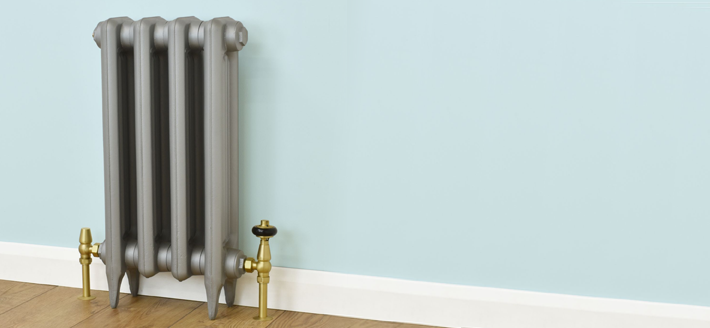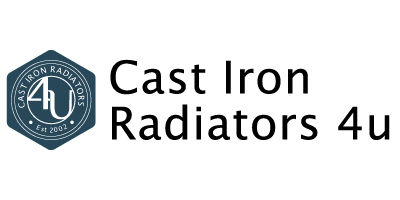How to Bleed Cast Iron Radiators
Posted by Cast Iron Radiators 4u on 28th May 2025
If your radiators are feeling cold at the top, or they aren’t heating up quite as well as they should, the problem could be trapped air. Regularly bleeding your radiators helps release this unwanted air, keeping your heating system running smoothly. In this guide, we’ll focus on how to bleed cast iron radiators, offering a clear, step-by-step method that’s simple to follow.
Whether you're a homeowner looking to maintain your heating system or a home decor enthusiast with a passion for period features, this guide will answer all the key questions about bleeding cast iron radiators, providing the practical knowledge you need to keep your heating system working at its very best.
What Are Cast Iron Radiators?

Cast iron radiators are one of the classic heating choices. With their durability and elegant design, they’ve been popular since Victorian times, and they’re still a top choice for both traditional and modern interiors today.
There are a few different types of cast iron radiators to consider, depending on the style of your home, including:
- Victorian-style radiators: Often ornate and decorative, these are perfect for period properties.
- Flat-Faced Column radiators: These have a simpler, more streamlined appearance, making them versatile for various decor styles.
- Modern cast iron radiators: These combine traditional materials with contemporary designs, offering both form and function.
But cast iron radiators are prized for their performance just as much as their looks. They retain heat much longer than standard radiators - so they will continue to warm your room long after your heating system has turned off.
How to Bleed Cast Iron Radiators - A Step-by-Step Guide
There aren’t many things you need to do to keep cast iron radiators running at their very best. But just like other types of hot water heating systems, bleeding your cast iron radiator is an essential maintenance task to help release trapped air. So, here’s our straightforward guide on how to bleed a radiator safely and effectively.
1. Turn Off Your Heating
First things first: make sure you’ve turned your heating system off. Bleeding a radiator without taking this first step means you could run the risk of hot water spraying out, which can be dangerous and messy. Always switch off your heating and let the radiator cool down completely before you begin.
2. Find the Bleed Valve
So, where is the bleed valve on a cast iron radiator? You’ll typically find it at the top of the radiator, on one side. The cast iron radiator bleed valve is a small square or round piece that you can turn to release trapped air.
3. Get Your Tools Ready
Most bleed valves require a radiator key, but if you’ve misplaced yours, it isn’t the end of the world! If you need to know how to bleed radiators without a key, there’s often another way to get the job done, including using a flathead screwdriver – this is particularly common on newer bleed valves.
That said, if you’re bleeding cast iron radiators with a screwdriver, always make sure it fits securely to avoid the possibility of causing any damage.
4. Place a Cloth or Bowl Under the Valve
Before opening the valve, remember to place an old towel or a small bowl underneath it. Aside from unwanted air, there’s plenty of water in your radiator, and at some point during the bleeding process, a small amount will come out. With a towel or bowl in place, you can catch any drips of water.
5. Open the Valve Slowly
Insert your radiator key (or screwdriver) into the bleed valve and turn it anti-clockwise. You shouldn’t need to turn too far - just a quarter to half a turn. You should then start to hear a hissing sound - that’s the air escaping.
6. Wait for Water to Appear
When water starts to steadily trickle out, it means you’ve released all the trapped air. Close the valve by turning it clockwise until it’s snug, but don’t over-tighten it!
7. Check Your Boiler Pressure
After bleeding, check the pressure gauge on your boiler. If the pressure has dropped too low, you may need to top it up again. You’ll need to follow the instructions in your boiler’s manual for that.
Cast Iron Radiators from Cast Iron Radiators 4u

At Cast Iron Radiators 4u, we specialise in high-quality cast iron radiators UK wide. Whether you’re looking for a modern cast iron radiator or a vintage-inspired design, you’ll find it here. We offer:
- A Wide Range of Products: From sleek column radiators to ornate antique styles, in a variety of sizes and finishes.
- Competitive Prices: We aim to offer the best value without compromising on quality.
- Expert Advice: Whether you’re trying to decide on the right style for you or you need to find out the right radiator size for your space, our knowledgeable team is always here to help.
Regular maintenance like bleeding your radiators will help to keep your heating system running smoothly and in turn, your home warm and comfortable. With durable construction and classic designs, our radiators don’t just heat your home – they can enhance your decor too. For more advice or to order from our full range of cast iron radiators, contact us today!
FAQs
Do you need to bleed cast iron radiators?
Yes. Like any radiator, cast iron radiators can develop trapped air over time, which prevents them from heating efficiently. Regular bleeding helps maintain performance.
How often should I bleed my radiators?
We recommend bleeding your radiators at least once a year, typically at the start of the heating season.
Why is my cast iron radiator not heating up?
Common causes include trapped air (requiring bleeding), a faulty valve, or a problem with the central heating system. Start by bleeding the radiator to rule out air as the cause.
How does water flow through a cast iron radiator?
Water enters through the inlet valve, flows through the columns or sections, and exits via the outlet valve. The heat from the water warms the cast iron, which then radiates heat into the room.
Can I bleed my radiator without a key?
Yes. Many modern bleed valves can be opened with a flathead screwdriver. If you’re unsure, check the type of valve before attempting to bleed.
What happens if you bleed a radiator with the heating on?
It’s not recommended! Hot water and steam can escape and cause injury or damage. Always turn off your heating and let your radiators cool before bleeding.


